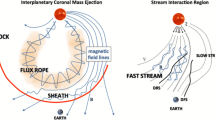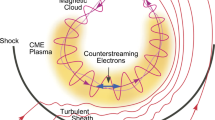Abstract
Interplanetary shocks are important precursors of interplanetary coronal mass ejections (ICMEs) and corotating interaction regions (CIRs). The shock compression and draping effects on the interplanetary magnetic field (IMF) in sheaths can lead to significant geomagnetic activity. We identified 297 fast forward shocks observed by the Advanced Composition Explorer spacecraft upstream of the Earth, and analyzed their geomagnetic impacts in solar cycle (SC) 23 (1998–2008) and SC24 (2009–2018). The shock (normalized) occurrence rate is found to be significantly higher during SC23 compared to SC24, and it exhibits a stronger correlation with the sunspot number during SC23 (correlation coefficient \(r = 0.93\)) than during SC24 (\(r = 0.86\)). The average shock compressions of the IMF magnitude and plasma density are \(\approx 2.0\) and \(\approx 2.4\), respectively, with no significant correlation with geomagnetic activity. Variations of solar wind parameters and geomagnetic activity indices following the shock arrival are explored. An interval of 6 h (3 days) following the shock is characterized by the average peak values of solar wind speed \(V_{\textrm{sw}} = 525~(610)\) km s\(^{-1}\), IMF \(B_{\textrm{z}} = -6.5~(-11.1)\) nT, and electric field \(E_{\textrm{y}} = 3.5~(6.1)\) mV m\(^{-1}\), followed by the average peak geomagnetic indices of \(\textrm{Dst}=-36~(-83)\) nT, \(\textrm{ap}=56~(92)\) nT, and \(\textrm{AE}=733~(1061)\) nT. About 25% and 63% of the shocks are followed by geomagnetic storms with \(\textrm{Dst}\le -50\) nT in the following 6-h and 3-day periods, respectively. The percentages of shocks followed by the auroral activity level \(\textrm{AE}>500\) nT are \(\approx 65\)% and \(\approx 96\)% for the short and long intervals, respectively. For the ap activity level (\(>56\) nT), the geoeffective shocks are \(\approx 30\)% and \(\approx 60\)%, respectively. The overall increase in the geomagnetic activity after the shock arrival for the longer shock-preceded interval is possibly due to inclusion of contributions from shock driver (ICME or CIR) fields. It can be concluded that an interplanetary fast forward shock has a probability of 1/4 to be followed by geomagnetic storms, and of 2/3 to be followed by significant auroral activity. We derived probability distribution functions of geomagnetic indices for the 6-h and 3-day intervals following shocks. The results might be important for space weather modeling and applications.






Similar content being viewed by others
Data Availability
The solar wind plasma and IMF data used in this work are obtained from the ACE Science Center (http://www.srl.caltech.edu/ACE/ASC/level2/). The geomagnetic indices are collected from the OMNIweb database (https://omniweb.gsfc.nasa.gov/). The SSN data are obtained from the Royal Observatory of Belgium (https://wwwbis.sidc.be/silso/home).
References
E.N. Parker, Dynamics of the interplanetary gas and magnetic fields. Astrophys. J. 128, 664–676 (1958). https://doi.org/10.1086/146579
D.F. Webb, T.A. Howard, Coronal mass ejections: Observations. Liv. Rev. Solar Phys. 9, 1–83 (2012). https://doi.org/10.12942/lrsp-2012-3
A. Balogh, V. Bothmer, N.U. Crooker, R.J. Forsyth, G. Gloeckler, A. Hewish, M. Hilchenbach, R. Kallenbach, B. Klecker, J.A. Linker, E. Lucek, G. Mann, E. Marsch, A. Posner, I.G. Richardson, J.M. Schmidt, M. Scholer, Y.M. Wang, R.F. Wimmer-Schweingruber, M.R. Aellig, P. Bochsler, S. Hefti, Z. Mikii, The solar origin of corotating interaction regions and their formation in the inner heliosphere. Space Sci. Rev. 89, 141–178 (1999). https://doi.org/10.1023/A:1005245306874
A.J. Hundhausen, Coronal Expansion and Solar Wind (Springer-Verlag. Berlin (1972). https://doi.org/10.1007/978-3-642-65414-5
E.J. Smith, J.H. Wolfe, Observations of interaction regions and corotating shocks between one and five AU: Pioneers 10 and 11. Geophys. Res. Lett. 3, 137–140 (1976). https://doi.org/10.1029/GL003i003p00137
L.F. Burlaga, Interplanetary magnetohydrodynamics, vol. 3 (Oxford University Press) 272 (1995)
D. Burgess, in Introduction to Space Plasma Physics, ed. by M.G. Kivelson, C.T. Russell (Cambridge University Press, Cambridge - UK) Chapter 5 (1995)
A.J. Hundhausen, The Solar Wind (Cambridge University Press, Cambridge, 1995), pp.91–128
B. Heber, T. Sanderson, M. Zhang, Corotating interaction regions. Adv. Space Res. 23, 567–579 (1999). https://doi.org/10.1016/S0273-1177(99)80013-1
L. Jian, C.T. Russell, J.G. Luhhmann, R.M. Skoug, Properties of stream interactions at one AU during 1995–2004. Sol. Phys. 239, 337–392 (2006). https://doi.org/10.1007/s11207-006-0132-3
R. Schwenn, Space weather: The solar perspective. Liv. Rev. Sol. Phys. 3, 1–72 (2006). https://doi.org/10.1007/s41116-021-00030-3
B.T. Tsurutani, G.S. Lakhina, O.P. Verkhoglyadova, W.D. Gonzalez, E. Echer, F.L. Guarnieri, A review of interplanetary discontinuities and their geomagnetic effects. J. Atmos. Sol. Terr. Phys. 73, 5–19 (2011a). https://doi.org/10.1016/j.jastp.2010.04.001
E.K.J. Kilpua, E. Lumme, K. Andreeova, A. Isavnin, H.E.J. Koskinen, Properties and drivers of fast interplanetary shocks near the orbit of the Earth (1995-2013). J. Geophys. Res. 120, 4112–4125 (2015). https://doi.org/10.1002/2015JA021138
I.G. Richardson, Solar wind stream interaction regions throughout the heliosphere. Liv. Rev. Sol. Phys. 15, 1–95 (2018). https://doi.org/10.1007/s41116-017-0011-z
E. Echer, M.J.A. Bolzan, A.M.S. Franco, Statistical analysis of solar wind parameter variation with heliospheric distance: Ulysses observations in the ecliptic plane. Adv. Space Res. 65, 2846–2856 (2020). https://doi.org/10.1016/j.asr.2020.03.036
R. Hajra, J.V. Sunny, Corotating interaction regions during solar cycle 24: A study on characteristics and geoeffectiveness. Sol. Phys. 297, 30 (2022). https://doi.org/10.1007/s11207-022-01962-1
E. Echer, W.D. Gonzalez, L.E.A. Vieira, A. Dal Lago, F.L. Guarnieri, A. Prestes, A.L.C. Gonzalez, N.J. Schuch, Interplanetary shock parameterse during solar activity maximum 2000 and minimum 1995–1996. Brazilian J. Phys. 33, 115–122 (2003). https://doi.org/10.1590/S0103-97332003000100010
E. Echer, Interplanetary shock parameters near Jupiter’s orbit. Geophys. Res. Lett. 46, 5681–5688 (2019). https://doi.org/10.1029/2019GL082126
E. Echer, Solar wind and interplanetary shock parameters near Saturn’s orbit (~10 au). Planet. Space Sci. 165, 210–220 (2019). https://doi.org/10.1016/j.pss.2018.10.006
R. Hajra, Variation of the interplanetary shocks in the inner heliosphere. Astrophys. J. 917, 91 (2021). https://doi.org/10.3847/1538-4357/ac0897
H.V. Cane, The evolution of interplanetary shocks. J. Geophys. Res. 90, 191–197 (1985). https://doi.org/10.1029/JA090iA01p00191
N.R. Sheeley, R.A. Howard, M.J. Koomen, D.J. Michels, R. Schwenn, K.H. Muser, H. Rosenbauer, Coronal mass ejections and interplanetary shocks. J. Geophys. Res. 90, 163–175 (1985). https://doi.org/10.1029/JA090iA01p00163
E. Echer, W.D. Gonzalez, B.T. Tsurutani, L.E.A. Vieira, M.V. Alves, A.L.C. Gonzalez, On the preferential occurrence of interplanetary shocks in July and November: Causes (solar wind annual dependence) and consequences (intense magnetic storms). J. Geophys. Res. 110, A02,101 (2005a). https://doi.org/10.1029/2004JA010527
T. Gold, in Gas Dynamics of Cosmic Clouds. 2, 97 (1955)
J.C. Foster, J.R. Wygant, M.K. Hudson, A.J. Boyd, B.D. N., P.j. Erickson, H.E. Spence, Shock-induced prompt relativistic electron acceleration in the inner magnetosphere. J. Geophys. Res 120(3), 1661–1674 (2015). https://doi.org/10.1002/2014JA020642
S.G. Kanekal, D.N. Baker, J.F. Fennell, A. Jones, Q. Schiller, I.G. Richardson, X. Li, D.L. Turner, S. Califf, S.G. Claudepierre, L.B. Wilson III, A. Jaynes, J.B. Blake, G.D. Reeves, H.E. Spence, C.A. Kletzing, J.R. Wygant, Prompt acceleration of magnetospheric electrons to ultrarelativistic energies by the 17 March 2015 interplanetary shock. J. Geophys. Res. 121, 7622–7635 (2016). https://doi.org/10.1002/2016JA022596
R. Hajra, B.T. Tsurutani, in Extreme Events in Geospace: Origins, Predictability, and Consequences, ed. by N. Buzulukova (Elsevier), pp. 373–400 (2018a). https://doi.org/10.1016/B978-0-12-812700-1.00014-5
D.M. Oliveira, A.A. Samsonov, Geoeffectiveness of interplanetary shocks controlled by impact angles: A review. Adv. Space Res. 61, 1–44 (2018). https://doi.org/10.1016/j.asr.2017.10.006
E. Echer, B.T. Tsurutani, W.D. Gonzalez, Interplanetary fast forward shocks and their geomagnetic effects: Cawses events. J. Atmos. Sol. Terr. Phys. 73, 1330–1338 (2011). https://doi.org/10.1016/j.jastp.2010.09.020
B.T. Tsurutani, E. Echer, W.D. Gonzalez, The solar and interplanetary causes of the recent minimum in geomagnetic activity (MGA23): A combination of mid latitude small coronal holes, low IMF Bz variances, low solar wind speeds and low solar magnetic fields. Ann. Geophys. 29, 839–849 (2011). https://doi.org/10.5194/angeo-29-839-2011
B.T. Tsurutani, R. Hajra, The interplanetary and magnetospheric causes of geomagnetically induced currents (GICs)>10 A in the Mäntsälä Finland pipeline: 1999 through 2019. J. Space Weather Space Clim. 11, 23 (2021). https://doi.org/10.1051/swsc/2021001
B.T. Tsurutani, W.D. Gonzalez, F. Tang, S.I. Akasofu, E.J. Smith, Origin of interplanetary southward magnetic fields responsible for major magnetic storms near solar maximum (1978-1979). J. Geophys. Res. 93, 8519–8531 (1988). https://doi.org/10.1029/JA093iA08p08519
D.J. McComas, J.T. Gosling, S.J. Bame, E.J. Smith, H.V. Cane, A test of magnetic field draping induced Bz perturbations ahead of fast coronal mass ejecta. J. Geophys. Res. 94, 1465–1471 (1989). https://doi.org/10.1029/JA094iA02p01465
W.D. Gonzalez, B.T. Tsurutani, A.L. Clua de Gonzalez, Interplanetary origin of geomagnetic storms. Space Sci. Rev. 88, 529–562 (1999). https://doi.org/10.1023/A:1005160129098
E. Kilpua, H.E.J. Koskinen, T.I. Pulkkinen, Coronal mass ejections and their sheath regions in interplanetary space. Liv. Rev. Sol. Phys. 14, 1–83 (2017). https://doi.org/10.1007/s41116-017-0009-6
W.D. Gonzalez, E. Echer, B.T. Tsurutani, A.L. Gonzalez, A. Lago, Interplanetary origin of intense, superintense and extreme geomagnetic storms. Space Sci. Rev. 158, 69–89 (2011). https://doi.org/10.1007/s11214-010-9715-2
E. Echer, W.D. Gonzalez, Geoeffectiveness of interplanetary shocks, magnetic clouds, sector boundary crossings and their combined occurrence. Geophys. Res. Lett. 31, 1–4 (2004). https://doi.org/10.1029/2003GL019199
E. Echer, M.V. Alves, W.D. Gonzalez, Geoeffectiveness of interplanetary shocks during solar minimum (1995–1996) and solar maximum (2000). Sol. Phys. 221, 361–280 (2004). https://doi.org/10.1016/j.pss.2018.10.006
E. Echer, W.D. Gonzalez, M.V. Alves, On the geomagnetic effects of solar wind interplanetary magnetic structures. Space Weather 4, 1–16 (2006). https://doi.org/10.1029/2005SW000200
M.V. Alves, E. Echer, W.D. Gonzalez, Geoeffectiveness of solar wind interplanetary magnetic structures. J. Atmos. Sol. Terr. Phys. 73(73), 1380–1384 (2011). https://doi.org/10.1016/j.jastp.2010.07.024
F. Cletee, F. Lefevre, The new sunspot number: assembling all corrections. Sol. Phys. 291, 2629–2651 (2016). https://doi.org/10.1007/s11207-016-1014-y
J.C. Davis, Statistics and Data Analysis in Geoglogy (Wiley, 2002)
M. Sugiura, Hourly values of equatorial Dst for the IGY. Ann. Intern. Geophys. Year 35, 9 (1964)
G. Rostoker, Geomagnetic indices. Rev. Geophys. 10, 935–950 (1972). https://doi.org/10.1029/RG010i004p00935
T.N. Davis, M. Sugiura, Auroral electrojet activity index AE and its universal time variations. J. Geophys. Res. 71, 785–801 (1966). https://doi.org/10.1029/JZ071i003p00785
M. Janvier, R.M. Winslow, S. Good, E. Bonhomme, P. Démoulin, S. Dasso, C. Mestl, N. Lugaz, T. Amerstorfer, E. Soubrié, P.D. Boakes, Generic magnetic field intensity profiles of interplanetary coronal mass ejections at Mercury, Venus, and Earth from superposed epoch analyses. J. Geophys. Res. 124, 812–836 (2019). https://doi.org/10.1029/2018JA025949
W.D. Gonzalez, J.A. Joselyn, Y. Kamide, H.W. Kroehl, G. Rostoker, B.T. Tsurutani, V.M. Vasyliunas, What is a geomagnetic storm? J. Geophys. Res. 99, 5771–5792 (1994). https://doi.org/10.1029/93JA02867
B.T. Tsurutani, G.S. Lakhina, E. Echer, R. Hajra, C. Nayak, A.J. Mannucci, X. Meng, Comment on “Modeling extreme “Carrington-type” space weather events using three-dimensional global MHD simulations by C. M. Ngwira, A. Pulkkinen, M. M. Kuznetsova, and A. Glocer”. J. Geophys. Res. 123, 1388–1392 (2018). https://doi.org/10.1002/2017JA024779
R. Hajra, B.T. Tsurutani, Near-Earth sub-Alfvénic solar winds: Interplanetary origins and geomagnetic impacts. Astrophys. J. 926, 135 (2022). https://doi.org/10.3847/1538-4357/ac4471
E. Echer, W.D. Gonzalez, B.T. Tsurutani, A.L.C. Gonzalez, Interplanetary conditions causing intense geomagnetic storms (Dst<-100 nT) during solar cycle 23 (1996–2006). J. Geophys. Res. 113, 1–20 (2008). https://doi.org/10.1029/2007JA012744
M.M.F. Saba, W.D. Gonzalez, A.L. Clúa de Gonzalez, Relationships between the AE, ap and Dst indices near solar minimum (1974) and at solar maximum (1979). Ann. Geophys. 15, 1265–1270 (1997). https://doi.org/10.1007/s00585-997-1265-x
R. Hajra, B.T. Tsurutani, Interplanetary shocks inducing magnetospheric supersubstorms (SML<-2500 nT): Unusual auroral morphologies and energy flow. Astrophys. J. 858, 123 (2018). https://doi.org/10.3847/1538-4357/aabaed
B.T. Tsurutani, R. Hajra, Energetics of shock triggered supersubstorms (SML<-2500 nT). Astrophys. J 946, 17, (2023). https://doi.org/10.3847/1538-4357/acb143
K.E.J. Huttunen, J.E.J. Koskinen, Importance of post-shock streams and sheath regions as drivers of intense magnetospheric storms and high latitude activity. Ann. Geophys. 22, 1729–1738 (2004). https://doi.org/10.5194/angeo-22-1729-2004
Acknowledgements
E. E. would like to thank Brazilian agencies for research grants: CNPq (contract no. PQ-302583/2015-7, PQ-301883/2019-0) and FAPESP (2018/21657-1). A. L. and L. E. S. N. would like to thank the PIBIFSP Program for the fellowship received during 2019 and 2020 as well as CAPES – Brazilian Federal Agency - and CAP/INPE Pos Graduation Program for the Master's fellowship. The work of R. H. is funded by the Science and Engineering Research Board (SERB, grant no. SB/S2/RJN-080/2018), a statutory body of the Department of Science and Technology (DST), Government of India through the Ramanujan fellowship. The work of A. M. S. F. is funded by the Brazilian CNPq agency (project no. PQ-300969/2020-1, PQ-301542/2021-0). The work of M. J. A. B. was supported by CNPq agency (contract no. PQ-302330/2015-1, PQ-305692/2018-6) and FAPEG agency (contract no. 2012.1026.7000905). We thank the Brazilian Ministry of Science, Technology and Innovation and the Brazilian Space Agency as well. The solar wind plasma and IMF data used in this work are obtained from the ACE Science Center (http://www.srl.caltech.edu/ACE/ASC/level2/). The geomagnetic indices are collected from the OMNIweb database (https://omniweb.gsfc.nasa.gov/). The SSN data are obtained from the Royal Observatory of Belgium (https://wwwbis.sidc.be/silso/home).
Funding
A. M. S. F was funded by FAPESP (projects 2016/10794-2 and 2017/00516-8) and CNPq agency (projects PQ-300969/2020-1, PQ-301542/2021-0). E. E. received grants from FAPESP (2018/21657-1) and CNPq (PQ-301883/2019-0) agencies. M. J. A. B. was supported by CNPq agency contract number (PQ-305692/2018-6) and FAPEG agency contract number 2012. 1026.7000905. R. H. received support from the Science and Engineering Research Board grant SB/S2/RJN-080/2018.
Author information
Authors and Affiliations
Corresponding author
Ethics declarations
Ethics Approval
The work followed better human and scientific practices.
Consent to Participate
All participants consent to the work.
Consent for Publication
All participants consent for publication.
Conflict of Interest
The authors declare no competing interests.
Additional information
Publisher's Note
Springer Nature remains neutral with regard to jurisdictional claims in published maps and institutional affiliations.
Rights and permissions
Springer Nature or its licensor (e.g. a society or other partner) holds exclusive rights to this article under a publishing agreement with the author(s) or other rightsholder(s); author self-archiving of the accepted manuscript version of this article is solely governed by the terms of such publishing agreement and applicable law.
About this article
Cite this article
Echer, E., Lucas, A.d., Hajra, R. et al. Geomagnetic Activity Following Interplanetary Shocks in Solar Cycles 23 and 24. Braz J Phys 53, 79 (2023). https://doi.org/10.1007/s13538-023-01294-w
Received:
Accepted:
Published:
DOI: https://doi.org/10.1007/s13538-023-01294-w




